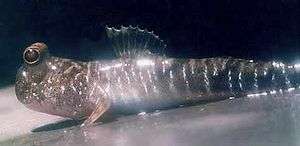Amphibious fish

Amphibious fish are fish that are able to leave water for extended periods of time. About 11 distantly related genera of fish are considered amphibious. This suggests that many fish genera independently evolved amphibious traits, a process known as convergent evolution. These fish use a range of terrestrial locomotory modes, such as lateral undulation, tripod-like walking (using paired fins and tail), and jumping. Many of these locomotory modes incorporate multiple combinations of pectoral, pelvic and tail fin movement.
Many ancient fish had lung-like organs, and a few, such as the lungfish, still do. Some of these ancient "lunged" fish were the ancestors of tetrapods. However, in most recent fish species these organs evolved into the swim bladders, which help control buoyancy. Having no lung-like organs, modern amphibious fish and many fish in oxygen-poor water use other methods such as their gills or their skin to breathe air. Amphibious fish may also have eyes adapted to allow them to see clearly in air, despite the density differences between air and water.
List of amphibious fish
Lung breathers
- Lungfish (Dipnoi): Six species, have limb like fins, and can breathe air. Some are obligate air breathers, meaning they will drown if not given access to breathe air. Some species will bury in the mud when the body of water they live in dries up, surviving up to two years until water returns.
- Various other "lunged" fish: now extinct, a few of this group were ancestors of the basal tetrapods that led to all tetrapods: Lissamphibia, sauropsids and mammals.
Gill or skin breathers
- Rockskippers: These blennies are found in Panama and elsewhere on the western coastline of the Americas. These fish come onto land to catch prey and escape aquatic predators. They often come out of water for up to 20 minutes. Leaping blennies (Alticus arnoldorum) are able to jump over land using their tails .
- Woolly sculpin (Clinocottus analis): Found in tide pools along the Pacific coast, these sculpins will leave water if the oxygen levels get low and can breathe air.[1]
- Mudskippers (Oxudercinae): This subfamily of gobies is probably the most land adapted of fish. Mudskippers are found in mangrove swamps in Africa and the Indo-Pacific, they frequently come onto land and can survive in air for up to three and a half days.[2] Mudskippers breathe through their skin and through the lining of the mouth (the mucosa) and throat (the pharynx). This requires the mudskipper to be wet, limiting mudskippers to humid habitats. This mode of breathing, similar to that employed by amphibians, is known as cutaneous breathing. They propel themselves over land on their sturdy forefins.
- Eels: Some eels, such as the European eel and the American eel, can live for an extended time out of water and can crawl on land if the soil is moist.
- Snakehead fish (Channidae): This family of fish are obligate air breathers, breathing air using their suprabranchial organ, which is a primitive labyrinth organ. The northern snakehead of Southeast Asia can "walk" on land by wriggling and using its pectoral fins, which allows it to move between the slow-moving, and often stagnant and temporary bodies of water in which it lives.
- Airbreathing catfish (Clariidae): Amphibious species of this family may venture onto land in wet weather, such as the eel catfish (Channallabes apus), which lives in swamps in Africa, and is known to hunt beetles on land.[3]
- Labyrinth fish (Anabantoidei). This suborder of fish also use a labyrinth organ to breathe air. Some species from this group can move on land. Amphibious fish from this family are the climbing perches, African and Southeast Asian fish that are capable of moving from pool to pool over land by using their pectoral fins, caudal peduncle and gill covers as a means of locomotion. It is said that climbing gourami move at night in groups.
